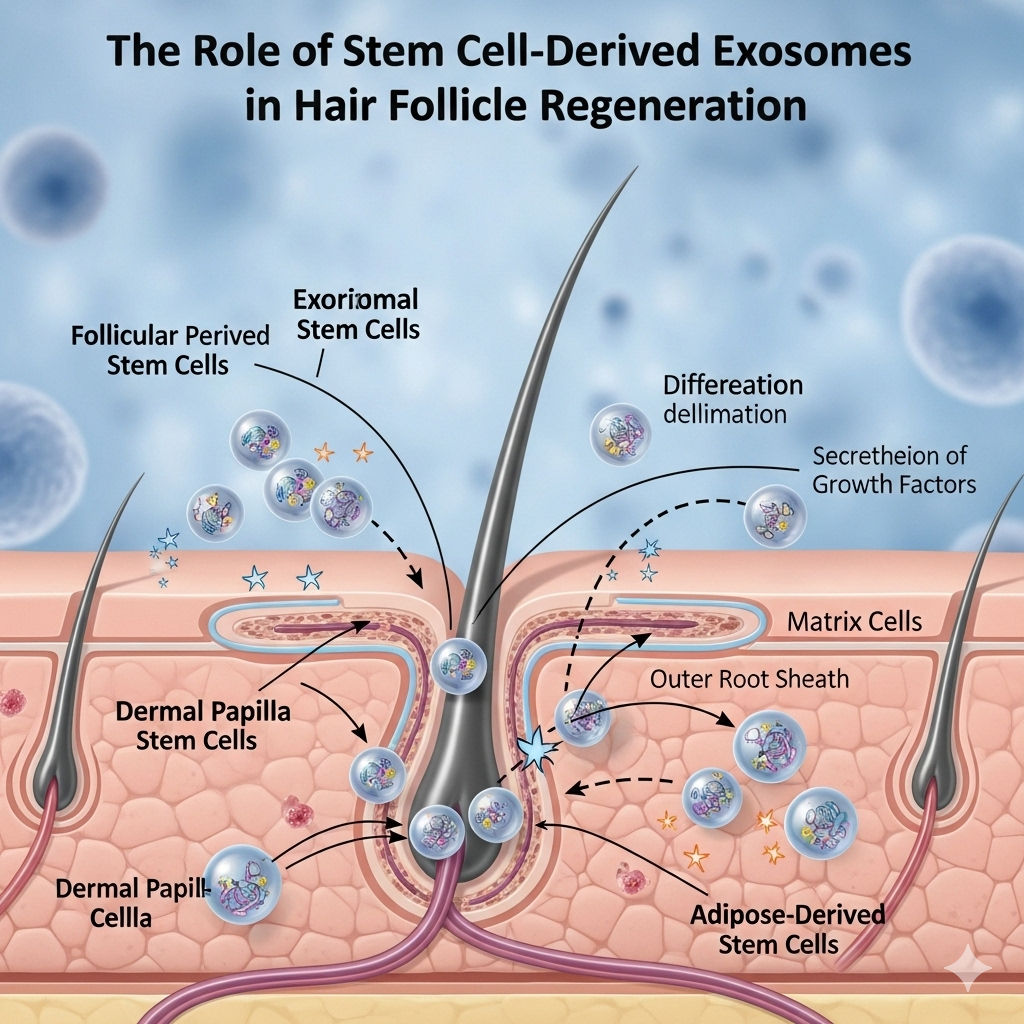Hair loss is often seen as an inevitable part of aging or genetics. But thanks to cutting-edge innovations in regenerative medicine, particularly stem cell-derived exosomes, we may be entering a new era of hair restoration—one that doesn’t just treat symptoms, but helps rejuvenate the hair follicle at the cellular level.
At ZMD Hair, we stay at the forefront of science-backed treatments, including the latest in exosome therapy. This blog explores what stem cell-derived exosomes are, how they work, and why they may be a game-changer in promoting healthy, natural hair regrowth.
What Are Exosomes?
Exosomes are tiny extracellular vesicles—microscopic messengers released by nearly all cells, including stem cells. Think of them as nature’s delivery system. These nanocarriers contain potent biological cargo such as proteins, lipids, mRNA, and growth factors, all of which can influence how nearby cells behave.
When derived from mesenchymal stem cells (MSCs), exosomes exhibit powerful regenerative properties, making them ideal for applications in skin repair, wound healing, and now, hair follicle regeneration.
How Exosomes Help Stimulate Hair Growth
Hair loss often occurs when hair follicles become dormant, miniaturized, or inflamed. Exosomes offer a non-surgical, biologically intelligent solution. When applied to the scalp, they don’t just sit on the surface—they interact with the hair follicle environment in ways that can spark regeneration.
Exosomes Encourage Follicle Communication
Hair follicles are part of a complex microenvironment that relies on cell-to-cell communication. Exosomes act as molecular messengers that reignite this communication, stimulating growth cycles and resetting follicles from the resting (telogen) to the active growth phase (anagen).
They Reduce Inflammation
Many types of hair loss, including androgenetic alopecia and alopecia areata, are linked to chronic inflammation at the follicle level. Exosomes carry anti-inflammatory cytokines that help calm the immune response, allowing follicles to function without interference.
They Promote Angiogenesis
Exosomes contain vascular endothelial growth factor (VEGF), which helps stimulate the formation of new blood vessels. This increased blood flow delivers more oxygen, nutrients, and signaling molecules to the follicles—exactly what’s needed to support thicker, healthier strands.
What Does the Science Say?
While exosome therapy is still considered emerging, scientific research is already showing promising results.
- A 2020 study in Stem Cells International found that exosomes derived from adipose-derived stem cells promoted hair growth in mice and improved dermal papilla cell proliferation—a key player in hair follicle cycling.
- In a 2022 clinical study, patients receiving MSC-derived exosome injections in thinning areas showed significant increases in hair density and scalp coverage within 12 weeks, with minimal side effects.
- Laboratory tests have confirmed that exosomes can stimulate Wnt/β-catenin signaling—a crucial pathway for hair follicle development and regrowth.
While more large-scale human trials are underway, early results suggest that exosomes may rival or enhance traditional therapies like PRP (Platelet-Rich Plasma) and minoxidil, especially for individuals with resistant or chronic hair loss.
How Is Exosome Therapy Performed?
At ZMD Hair, exosome therapy is a simple, non-invasive procedure typically performed in-office. Here’s what you can expect:
Consultation and Scalp Analysis
Before anything else, our specialists will examine your scalp and hair health to determine if you’re a good candidate for exosome therapy. This includes reviewing your medical history and conducting digital scalp imaging if needed.
Topical or Injection-Based Delivery
The exosomes—sourced from rigorously tested, FDA-compliant laboratories—are applied directly to the scalp via microinjections or in combination with microneedling. This enhances absorption and allows the exosomes to reach the base of the hair follicles.
No Downtime, Minimal Risk
Unlike surgical procedures, exosome treatment requires no incisions or anesthesia. Most patients return to normal activities the same day, with little more than minor redness or tingling at the application site.
Exosomes vs. PRP: What’s the Difference?
While both PRP and exosomes use your body’s healing mechanisms, the key difference lies in where the growth signals come from.
- PRP is derived from your own blood and depends on the concentration of your natural platelets.
- Exosomes are lab-isolated messengers harvested from stem cells, meaning they are standardized, consistent, and not dependent on your personal biology.
For patients with autoimmune conditions, poor platelet quality, or those who didn’t respond well to PRP, exosomes offer a powerful alternative or complementary treatment.
Who Is a Good Candidate for Exosome Hair Therapy?
Exosome therapy may be suitable if you:
- Are in the early to moderate stages of hair thinning
- Have male or female pattern baldness (androgenetic alopecia)
- Suffer from stress-related or inflammatory hair loss
- Have plateaued on minoxidil, finasteride, or PRP
- Prefer a non-surgical, minimally invasive solution
It’s important to note that patients with complete follicle loss may not respond as well, as exosomes work by rejuvenating existing or dormant follicles, not generating new ones.
Combining Exosomes with a Comprehensive Hair Restoration Plan
As powerful as they are, exosomes are not a magic bullet. At ZMD Hair, we believe the best results come from combining advanced therapies with lifestyle, nutritional, and medical support.
A customized plan may include:
- Exosome therapy to stimulate follicle regeneration
- PRP or microneedling to boost scalp healing
- Prescription treatments like finasteride or minoxidil
- Nutrient optimization through bloodwork-based supplementation
- Stress management and scalp hygiene routines
Our integrative approach ensures that each treatment enhances the others—giving you the strongest possible foundation for long-term hair health.
Conclusion: Exosomes Are the Future of Hair Restoration
Stem cell-derived exosomes are ushering in a new frontier in regenerative hair medicine. By leveraging the body’s own cellular language, these tiny messengers can reactivate dormant follicles, reduce inflammation, and support sustainable hair growth—without surgery or extensive downtime.
At ZMD Hair, we’re proud to offer exosome therapy as part of our commitment to cutting-edge, compassionate, and personalized care. Whether you’re just beginning to notice hair thinning or you’ve tried everything else with limited success, exosomes may be the breakthrough you’ve been waiting for.
Take the next step in your hair restoration journey.
Call (954) 302-6640 today or Visit ZMDHair to schedule a consultation with our expert team.




